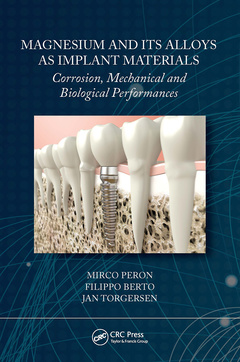Magnesium and Its Alloys as Implant Materials Corrosion, Mechanical and Biological Performances
Auteurs : Peron Mirco, Berto Filippo, Torgersen Jan

Chapter 1 Introduction
- Introduction
References
Chapter 2 Challenges and Common Strategies
- Introduction
- Corrosion Mitigation Strategies
- Impurities Removal
- Alloying
- Grain Size Modification
- Mechanical Properties Tuning
- Grain Refinement
- Solid Solution Strengthening
- Precipitation Hardening
- Interplay among Mechanical Properties, Corrosion
Resistance and Biocompatibility
References
Chapter 3 Synopsis of Properties of Biocompatible Mg and Its Alloys
- Introduction
- High-Pure Magnesium
- High-Pure Magnesium: Mechanical Properties
- High-Pure Magnesium: Corrosion Resistance
- High-Pure Magnesium: Biocompatibility
- Aluminum-Based Alloys
- AZ Alloys
- AZ Alloys: Mechanical Properties
- AZ Alloys: Corrosion Resistance
- AZ Alloys: Biocompatibility
- AM Alloys
- AM Alloys: Mechanical Properties
- AM Alloys: Corrosion Resistance
- AM Alloys: Biocompatibility
- Mg–Al–RE Alloys
- Mg–Al–RE Alloys: Mechanical Properties
- Mg–Al–RE Alloys: Corrosion
- Mg–Al–RE Alloys: Biocompatibility
- Mg–Zn Alloys
- Mg–Zn Binary Alloys
- Mg–Zn Binary Alloys: Mechanical Properties
- Mg–Zn Binary Alloys: Corrosion
- Mg–Zn Binary Alloys: Biocompatibility
- Mg–Zn–Zr Alloys
- Mg–Zn–Zr Alloys: Mechanical Properties
- Mg–Zn–Zr Alloys: Corrosion
- Mg–Zn–Zr Alloys: Biocompatibility
- Mg–Zn–Ca Alloys
- Mg–Zn–Ca Alloys: Mechanical Properties
- Mg–Zn–Ca Alloys: Corrosion
- Mg–Zn–Ca Alloys: Biocompatibility
- Mg–Zn–Ca BMGs
- Mg–Zn–Ca BMGs: Mechanical Properties
- Mg–Zn–Ca BMGs: Corrosion Resistance
- Mg–Zn–Ca BMGs: Biocompatibility
- Mg–Zn–Mn Alloys
- Mg–Zn–Mn Alloys: Mechanical Properties
- Mg–Zn–Mn Alloys: Corrosion
- Mg–Zn–Mn Alloys: Biocompatibility
- Mg–Zn–RE Alloys
- Mg–Zn–RE Alloys: Mechanical Properties
- Mg–Zn–RE Alloys: Corrosion
- Mg–Zn–RE Alloys: Biocompatibility
- Mg–Ca Alloys
- Mg–Ca Alloys: Mechanical Properties
- Mg–Ca Alloys: Corrosion Resistance
- Mg–Ca Alloys: Biocompatibility
- Mg–RE Alloys
- Mg–RE Alloys: Mechanical Properties
- Mg–RE Alloys: Corrosion Resistance
- Mg–RE Alloys: Biocompatibility
Resistance
Resistance
Resistance
Resistance
Resistance
Resistance
References
Chapter 4 Tackling the Challenges
- Introduction
- Radar Chart: An Easy Tool to Compare Corrosion, Mechanical and Biological Performances
References
Chapter 5 Outlook
Reference
Appendix A: Corrosion
Appendix B: In Vitro Biocompatibility Assessment
Index
Mirco Peron earned his degree in mechanical engineering (summa cum laude)
in 2015 from the University of Padova, where his thesis evaluated the fatigue
damage and stiffness evolution in composite laminates. He is currently a PhD
student at Norwegian University of Science and Technology (NTNU), Trondheim.
His PhD topic deals with the optimization of mechanical and corrosion
properties of magnesium and its alloys for biomedical applications, with particular
reference to the corrosion-assisted cracking phenomena.
Filippo Berto is Chair of Structural Integrity at the Norwegian University of
Science and Technology in Norway. He is in charge of the Mechanical and
Material Characterization Lab in the Department of Mechanical and Industrial
Engineering. He is author of more than 500 technical papers, mainly
oriented to materials science engineering, the brittle failure of different materials,
notch effect, the application of the finite element method to the structural
analysis, the mechanical behavior of metallic materials, the fatigue performance
of notched components as well as the reliability of welded, bolted and
bonded joints. Since 2003, he has been working on different aspects of the
structural integrity discipline, by mainly focusing attention on problems
related to the static and fatigue assessment of engineering materials with particular
attention to biomedical and medical applications and materials.
Jan Torgersen is Professor of mechanical engineering at NTNU, Trondheim.
He received his PhD from Vienna University of Technology, where he worked
on high-resolution laser microfabrication of hydrogels for tissue engineering.
He was
Date de parution : 06-2024
15.6x23.4 cm
Date de parution : 04-2020
15.6x23.4 cm
Thèmes de Magnesium and Its Alloys as Implant Materials :
Mots-clés :
Plasma Electrolytic Oxidation Coatings; ECAP; M1 Data; Solid Solution Strengthening Effect; Stress Shielding Phenomenon; High Pure Magnesium; Vice Versa; Severe Plastic Deformation Techniques; Simulated Body Fluid; Thermo Mechanical Processes; Solid Solution Strengthening; Alloying Element Concentration; Stress Corrosion Cracking; MgO Layer; Precipitation Hardening; Solid Solubility Limit; Alloying Elements; Maximum Solid Solubility; Corrosion Resistance; High Corrosion Rate; Corrosion Rate; Hard Tissue Applications; SST; Sol Gel Coatings; Corrosion Current Density



